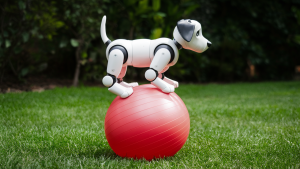AI trains robot dog to walk on a yoga ball

You have seen a bull-riding cowboy at a rodeo, now here is a robot dog able to balance and walk continuously on a yoga ball!
It is fun to watch the four-legged device move and adapt but it reinforces the serious capability of the technology and how AIs like GPT-4 appear to be training robots to perform difficult tasks more effectively than humans can.
DrEureka is responsible. It is an open-source software package used to train robots to carry out real instructions using LLMs such as ChatGPT 4.
Simulated physics is used in a virtual setting, the “sim-to-reality” system, before the tasks are performed in real life.
Jim Fan, one of the developers stated, “The Yoga ball task is particularly hard because it is not possible to accurately simulate the bouncy ball surface. Yet DrEureka has no trouble searching over a vast space of sim-to-real configurations, and enables the dog to steer the ball on various terrains, even walking sideways!”
We trained a robot dog to balance and walk on top of a yoga ball purely in simulation, and then transfer zero-shot to the real world. No fine-tuning. Just works.
I’m excited to announce DrEureka, an LLM agent that writes code to train robot skills in simulation, and writes more… pic.twitter.com/kuG14LmSOh
— Jim Fan (@DrJimFan) May 3, 2024
How does the LLM train the robot?“Domain randomization” is represented in the “Dr” of DrEureka. It stands for the randomizing of variable factors such as wetness, friction, mass, center of gravity, in a simulated situation.
By providing a few instructions in an LLM, AI can process the information to write code which determines a reward/punishment system to teach the robot, virtually, where 0 equals failure, and anything above zero is success — but the higher the score, the greater the reward. Framing can be carried out by setting the minimum and maximum breakage points for variables including the bounce of the ball, driving force, and limb movement.
With the powerful LLM, there is no trouble in creating the parameters in large quantities for the training system to execute the commands simultaneously — to allow the robot dog to do its thing on the yoga ball.
Image credit: Ideogram
The post AI trains robot dog to walk on a yoga ball appeared first on ReadWrite.
